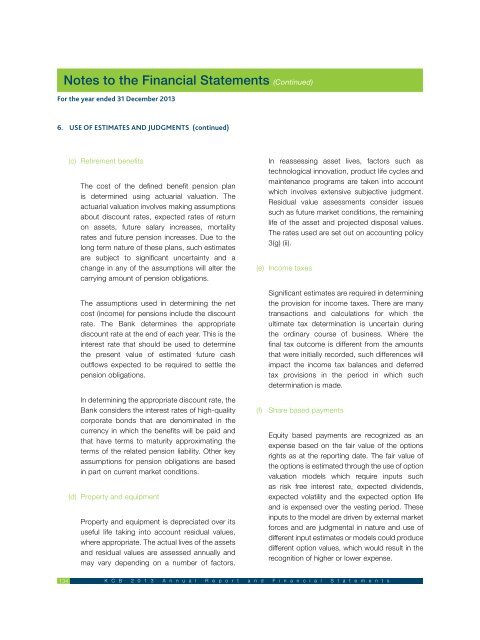Qd5INK
Qd5INK
Qd5INK
Create successful ePaper yourself
Turn your PDF publications into a flip-book with our unique Google optimized e-Paper software.
Notes to the Financial Statements (Continued)For the year ended 31 December 20136. USE OF ESTIMATES AND JUDGMENTS (continued)(c) Retirement benefitsThe cost of the defined benefit pension planis determined using actuarial valuation. Theactuarial valuation involves making assumptionsabout discount rates, expected rates of returnon assets, future salary increases, mortalityrates and future pension increases. Due to thelong term nature of these plans, such estimatesare subject to significant uncertainty and achange in any of the assumptions will alter thecarrying amount of pension obligations.The assumptions used in determining the netcost (income) for pensions include the discountrate. The Bank determines the appropriatediscount rate at the end of each year. This is theinterest rate that should be used to determinethe present value of estimated future cashoutflows expected to be required to settle thepension obligations.In determining the appropriate discount rate, theBank considers the interest rates of high-qualitycorporate bonds that are denominated in thecurrency in which the benefits will be paid andthat have terms to maturity approximating theterms of the related pension liability. Other keyassumptions for pension obligations are basedin part on current market conditions.(d) Property and equipmentProperty and equipment is depreciated over itsuseful life taking into account residual values,where appropriate. The actual lives of the assetsand residual values are assessed annually andmay vary depending on a number of factors.In reassessing asset lives, factors such astechnological innovation, product life cycles andmaintenance programs are taken into accountwhich involves extensive subjective judgment.Residual value assessments consider issuessuch as future market conditions, the remaininglife of the asset and projected disposal values.The rates used are set out on accounting policy3(g) (ii).(e) Income taxesSignificant estimates are required in determiningthe provision for income taxes. There are manytransactions and calculations for which theultimate tax determination is uncertain duringthe ordinary course of business. Where thefinal tax outcome is different from the amountsthat were initially recorded, such differences willimpact the income tax balances and deferredtax provisions in the period in which suchdetermination is made.(f) Share based paymentsEquity based payments are recognized as anexpense based on the fair value of the optionsrights as at the reporting date. The fair value ofthe options is estimated through the use of optionvaluation models which require inputs suchas risk free interest rate, expected dividends,expected volatility and the expected option lifeand is expensed over the vesting period. Theseinputs to the model are driven by external marketforces and are judgmental in nature and use ofdifferent input estimates or models could producedifferent option values, which would result in therecognition of higher or lower expense.27 134K C B 2 0 1 3 A n n u a l R e p o r t a n d F i n a n c i a l S t a t e m e n t s






